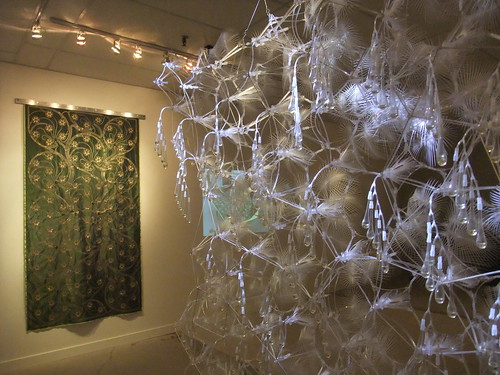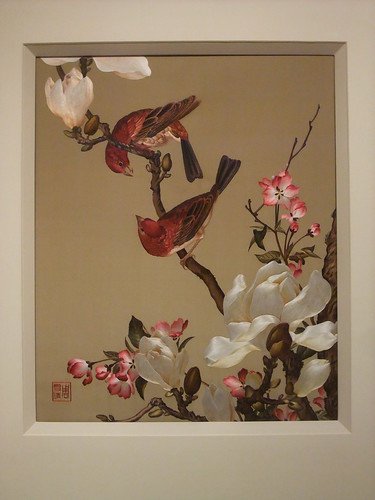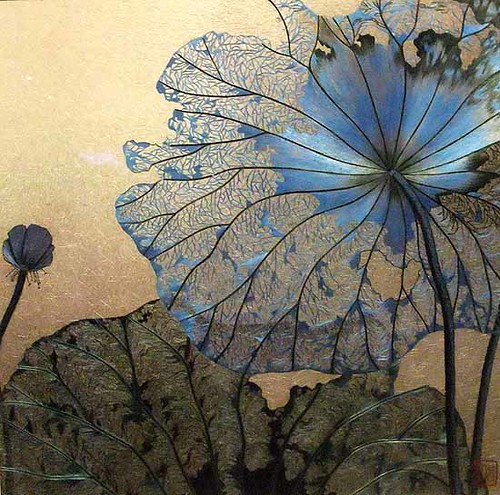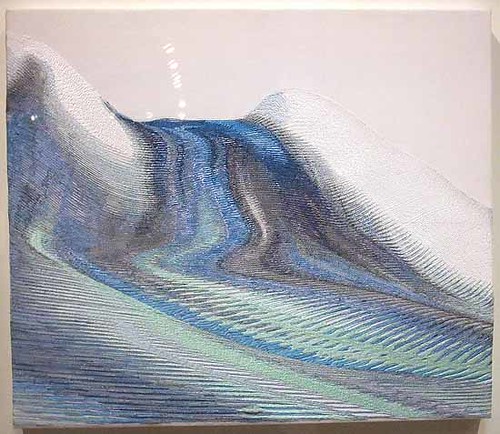Kate Findlay became fascinated with images of CERN's Large Hadron Collider (LHC) in 2008, and has been making quilts inspired by circular cross-sections of the machinery, and more recently, the underlying fundamental partical physics, ever since.
Breakthrough November 2009
Size: 90 cm square. Materials: silks, synthetics and cottons, a metal ring wrapped in gold cord, metallic mesh.
Hadron 2
Hadron 4 2009
Size: 60 cm square.
Materials: Fabric, wire, cords, foam board, on hardboard.
Note: This piece is not a quilt, although much of it is made with fabric.
Hadron 5
Atom - Silver
She's starting to get some attention from the physicists (like this article in CERN's Symmetry Magazine) who seem surprised that hard, metallic machinery who inspire soft textiles. I'd argue there is actually a history of employing quilts are a means of expressing contemporary society - which includes the science it produces. Consider for instance the collection of The Museum of Scientifically Accurate Fabric Brain Art, the Genone quilts of Beverly St. Clair, this EEG quilt or the astronomical quilts of Jimmy McBride (who goes by stellarquilts on Etsy). Nor is not a new phenomenon; consider for instance the Solar System quilt made by Ellen Harding Baker in 1876.
You can find more of Kate Findlay's LHC and particle physics quilts on her website along with other quilts she's made.
↬ adafruit industries blog
Tuesday, March 20, 2012
Hadrons and Textiles
Labels:
art about science,
Kate Findlay,
LHC,
particle physics,
textiles
Wednesday, March 14, 2012
Happy Pi (π) Day
Labels:
art about mathematics,
art about science,
irrational,
music,
numbers,
pi,
π
Tuesday, March 13, 2012
Solipsist
Solipsist is an experimental short film directed by LA-based Andrew Thomas Huang. It is visually stunning and reminds me of strange otherworldly art by Mœbius and Luigi Serafini, complete with creatures similar to but distinct from bioluminescent fish (of a craftier sort), alien folk costumes and unfathomnable human interactions. Watch it:
It won the Special Jury Prize for Experimental Short at SLAMDANCE 2012. The dancers, costume designers, puppet makers and masters, avant-guard make-up artists and CGI artists have created something quite astounding under Huang's direction. The combination of techniques is also used to great effect. The making of is also quite something:
I am glad such a thing exists.
↬ Etsy Tumblr
SOLIPSIST from Andrew Huang on Vimeo.
It won the Special Jury Prize for Experimental Short at SLAMDANCE 2012. The dancers, costume designers, puppet makers and masters, avant-guard make-up artists and CGI artists have created something quite astounding under Huang's direction. The combination of techniques is also used to great effect. The making of is also quite something:
SOLIPSIST - Making Of from Andrew Huang on Vimeo.
I am glad such a thing exists.
↬ Etsy Tumblr
Labels:
Andrew Huang,
art about science,
costumes,
dance,
film,
fish,
Luigi Serafini,
makeup,
Moebius,
multimedia,
puppetry,
surrealism
Monday, March 12, 2012
Mœbius
One artist who is universally revered amongst the comic book artists I've met is Mœbius, the nom de plume of French comic book artist Jean Henri Gaston Giraud (8 May 1938 – 10 March 2012). He worked under his own name, producing the Franco-Belgian comics western series, Blueberry, amongst others, and under the pseudonym Gir, but I know his otherworldly, surreal and beautiful work as Mœbius best. The statue on the left the little figure is facing, is in fact a self-portrait. He was famous for his science fiction work, including the wordless comix fantasy 'Arzach', his influence and involvement in film, and his mainstream comics work, including on The Silver Surfer. I've often thought about posting his uniquely imaginative art, which is so beautiful drawn and coloured that his talent left other artists at a lost for words. Sadly, it's his untimely death which is prompting me to do so today.
Labels:
art,
art about science,
comics,
Jean Henri Gaston Giraud,
Mœbius,
science fiction,
space,
surrealism
Friday, March 9, 2012
Math Translations
A brief post, in the category of writing about math, on a delightful* short article from McSweeney's by Kristopher Kelly.
(via, or symbolically, as she avocates ᔥ swissmiss)
*This is spot-on and, in my opinion, funny, despite the usual dreadfulness of math-humour.
(via, or symbolically, as she avocates ᔥ swissmiss)
*This is spot-on and, in my opinion, funny, despite the usual dreadfulness of math-humour.
Friday, March 2, 2012
Embroidering STITCHES

IMBLANKY by RAD on the left and Cloud Brocade by Philip Beesley on the right
I did not have an opportunity to post last month, but there were a number of interesting exhibits in Toronto, thanks to TODO the Toronto Design Offsite festival (part of the IDS). The premise of ‘STITCHES: Suzhou Fast Forward’ fascinated me. The show was at the Toronto experimental design centre and gallery, WORKshop, below ground and adjacent to Bay subway station. It promised to use the exquisite traditional craftsmanship of silk embroidery from China, as a sort of jumping off point for contemporary Canadian designers, architects, inventors and artists to riff on theme of embroidery. The show included seven hand-crafted embroidery pieces from the Zhou XueQing Embroidery Art Center in Guangdong, China, depicting luminous natural scenes with birds, flowers and landscapes in subtle, iridescent silk threads, some as fine as hair. They even provided magnifying glasses to really see the incredible detail.



The contemporary response played on the idea of embroidery. Eric Boyd from Hack Lab combined machine embroidery with a pretty (yes, pretty!) open source microcontroller called LilyPad Arduino, which was designed for ‘wearable’ applications, sewed to fabric employing electrically conductive thread. This allowed him to have changing patterns of flashing LED sequins. The Responsive Architecture at Daniels RAD team showed IMBLANKY, which appeared to be a green taffeta blanket with a modern, stylized pattern of bronze flowers. On closer inspection, each ‘flower’ is a tilt sensor made of conductive fabric, with the pattern of ‘stems’ actually acting as a circuit. Projected onto the wall was a demonstration of the blanket’s ‘sense’ of its own position: a short film showed a person moving the blanket and the simultaneous computer model produced from its data of its own 3D shape. Suspended from the ceiling was architect Philip Beesley’s Cloud Brocade, a ‘geotextile’. This is a strange and beautiful sculpture, like those of his you may have seen at Luminata or Nuit Blanche. A delicate net of airy, white, plastic flowers, hide hypodermic needles, through which they might inhale useful chemicals from the environment and collect them in tiny bulbs. He imagines a future where microprocessors and sensors embedded in art and architecture can play a role interactively in our environment – without ever forgetting aesthetics and design. Specific Objects Inc. and Steele and Tomczak each employed digital machine embroidery to mimic the detail of the Suzhou pieces in portraying the glacial formation of Moraine and all 58 km of Yonge St. in Street of Heaven, respectively. Williamson Chong Architects decided to add further dimensions to embroidery, presenting 3D printed art objects and a holographic projection, along with 2D prints.

Circuit Stitching (front and back) by Eric Boyd, Hack Lab

Moraine by Specific Objects Inc.


Street of Heaven by Steele and Tomczak

Stitches: Interstices by Williamson Chong Architects
I’ve always had great respect for needlework and the Chinese pieces are truly exquisite. I love how broadly the theme has been interpreted by those working in contemporary and perhaps even futuristic media. Imagine how both the ancient and the boundary-pushing, interactive contemporary designs could play in our own homes!
Subscribe to:
Posts (Atom)



















